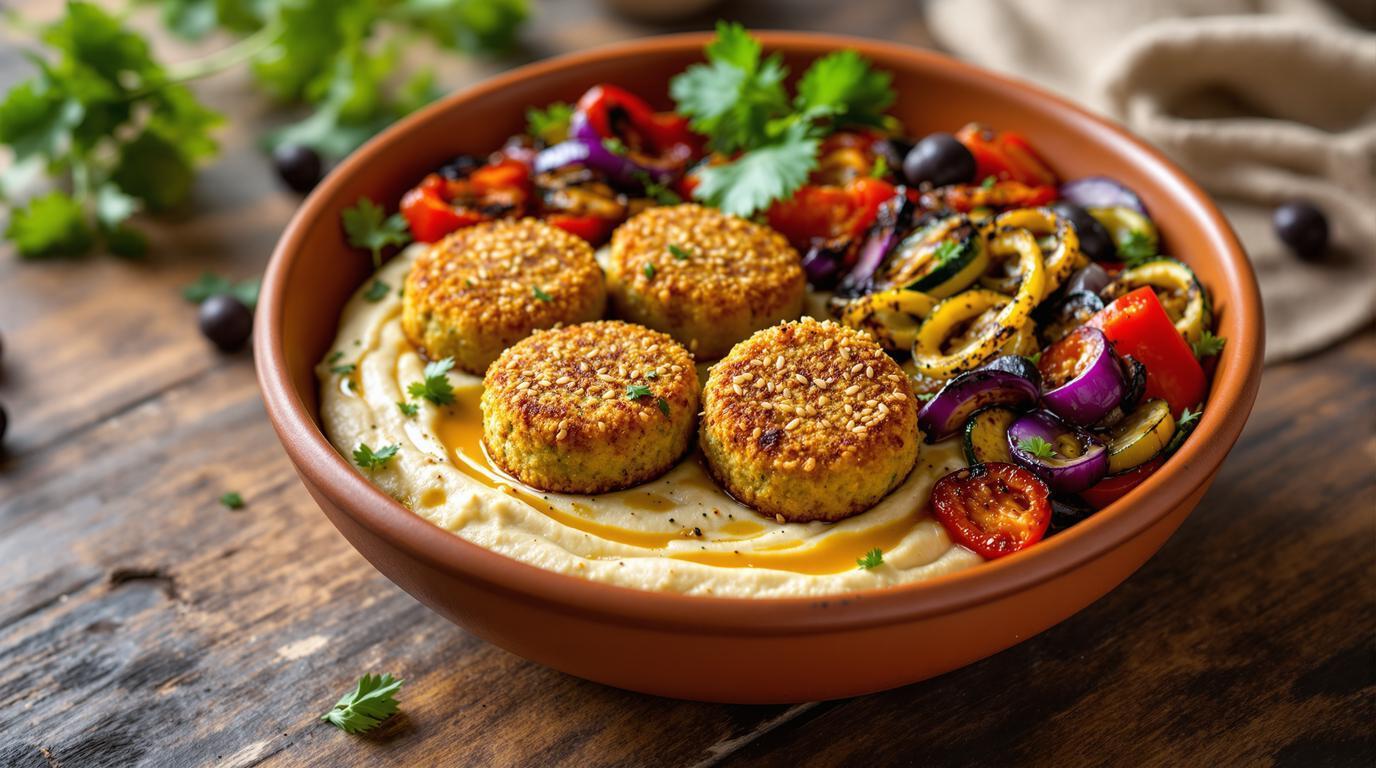I still remember the first time I tasted authentic falafel in a tiny street shop in Tel Aviv. The vendor—hands moving at lightning speed—transformed humble chickpeas into crispy, aromatic morsels that changed my understanding of Middle Eastern cuisine forever. Today I’m sharing my contemporary spin on this ancient dish: a vibrant falafel bowl that preserves traditional techniques while creating a complete meal experience. What makes this special? The contrasting textures and temperatures—hot, crispy falafel against cool, creamy hummus and charred, smoky vegetables.
The Story
Falafel has been enjoyed across the Middle East for centuries, with both Egyptian and Palestinian culinary traditions claiming it as their own. What began as street food has evolved into a global phenomenon, and for good reason. The secret lies in starting with dried chickpeas—never canned—soaked overnight until they’ve doubled in size. This traditional method creates that signature crispy-outside, fluffy-inside texture that’s simply impossible to achieve otherwise.
Ingredients Spotlight
For the falafel (serves 4-6):
- 1 pound (450g) dried chickpeas, soaked 8-12 hours
- 1 medium onion, roughly chopped
- 1 bunch fresh parsley (about 2 cups packed)
- 3 garlic cloves, peeled
- 1 medium potato, grated (optional for extra crunch)
- 1 teaspoon ground cumin
- 1 teaspoon ground coriander
- 2 teaspoons baking powder
- 3 tablespoons chickpea flour
- Avocado or grapeseed oil for frying
For the bowl assembly:
- Homemade hummus (250g cooked chickpeas, 2 Tbsp tahini, juice of 1 lemon, 1 garlic clove, 3 Tbsp warm water)
- Colorful grilled vegetables (red bell peppers, zucchini, eggplant, red onion, leeks)
- Tahini sauce (½ cup tahini, ¼ cup lemon juice, 1 garlic clove, ¼ cup warm water)
- Fresh lettuce leaves, olives, sumac for garnish
Step-by-Step Guide
1. Prepare the falafel mixture: Drain soaked chickpeas thoroughly. In a food processor, combine chickpeas, onion, parsley, garlic, potato (if using), cumin, and coriander. Pulse—don’t blend continuously—until you achieve a coarse, sandy texture. You should still see tiny pieces of chickpea; overmixing creates dense falafel.
2. Season and bind: Transfer to a bowl, add baking powder and chickpea flour. Mix by hand, then refrigerate for 1 hour to allow the ingredients to meld and the mixture to firm up.
3. Shape and fry: Form walnut-sized balls or small patties. Heat oil to exactly 330°F (165°C)—a temperature probe here is invaluable. Fry in batches of 6-8 for precisely 2-3 minutes until deep golden brown. The exteriors should audibly crackle when bitten.
4. Grill vegetables: Brush vegetables with olive oil, sprinkle with paprika, and grill over medium-high heat for 5-10 minutes until charred at the edges but still maintaining structure.
Chef’s Note: For the absolute best texture, your falafel mixture should barely hold together when formed. If it’s too wet, add a bit more chickpea flour; if it crumbles, add a tablespoon of ice water. When you drop a test ball into the oil, it should sizzle immediately but not violently—this indicates perfect temperature.
Expert Techniques
The signature crunch comes from both proper texture and frying technique. Maintain oil temperature by working in small batches—overcrowding the pan causes temperature drops that lead to oil-soaked, not crispy, falafel. For an additional traditional touch, roll formed falafel in sesame seeds before frying for a beautiful nutty crust.
When making the hummus, the sequence matters: blend chickpeas first until completely smooth, then add tahini, then lemon juice, and finally drizzle in ice water while the processor runs. This creates the silkiest texture that restaurant chefs achieve.
Presentation & Pairing Ideas
Build your bowl with intention—start with a base of lettuce, position falafels at 2, 5, and 10 o’clock positions, arrange vegetables by color gradient, then add a generous dollop of hummus in the center. Drizzle with tahini sauce and sprinkle sumac around the edges for both visual appeal and bright flavor contrast.
This bowl pairs beautifully with a crisp Alsatian white wine or, for non-alcoholic options, a mint-infused sparkling water with cucumber slices. During summer, try adding charred stone fruits to your vegetable selection; in winter, roasted root vegetables provide comforting sweetness.
Remember, the beauty of this bowl lies in its adaptability—once you’ve mastered the falafel technique, the canvas is yours to paint with seasonal produce and personal flavor preferences. The falafel itself is a vehicle for infinite culinary exploration, just as it has been for generations of innovative cooks across continents.
